Why is the Great Sphinx's nose missing?

Why is the Great Sphinx's nose missing?
An investigation into who damaged the Great Sphinx, near Giza, Egypt.
Contunico © ZDF Studios GmbH, Mainz; Thumbnail © Rasoul Ali/Dreamstime.com
Transcript
NARRATOR: The Sphinx - many myths and mysteries surround this ancient guardian of the pyramids. One question in particular poses a riddle to researchers - who mutilated the Sphinx's face, and why? Speculation has abounded throughout the centuries. One theory that enjoys particular popularity is that Napoleon Bonaparte had the Sphinx's nose shot off. In 1797 Napoleon devised a plan to conquer the lands around the Nile. He was the victor in the legendary Battle of the Pyramids. Did his cannons damage the ancient sculpture?
Napoleon was awed by the glorious past of his newly conquered territory. "Thousands of years of history are looking down upon us," he is said to have exclaimed upon seeing the monumental sculpture. And the triumphant general brought more than just soldiers into the land of the Pharaohs. He was accompanied by a large number of artists and scientists who shook the dust of history from ancient Egypt. Back in Europe, their discoveries unleashed a wave of Egyptomania. So it seems unlikely that Napoleon would have had the Sphinx thus disfigured. His army of painters and engravers produced fascinating images. And in all of them the Sphinx had already lost her nose.
DR. ZAHI HAWASS: "We have, really, to say to everyone that Napoleon Bonaparte has nothing to do with destroying the Sphinx's nose as people say. We believe, as Egyptologists, that there was a Sufi in the ninth century A.D. who came to the Sphinx and found that people had been worshipping the Sphinx as a god. He did not like that. He came with a metal, damaged the nose to show the people that this is stone and not a god."
NARRATOR: According to this theory a fanatical dervish named Muhammad Saim al-Dahr was responsible. He is said to have hired some men to smash off the Sphinx's nose as she was still worshipped as a false god. To this day, the Arabs refer to the Sphinx as Abul Hol or father of terror. By disfiguring the Sphinx's face in this way, the fanatics also took away her identity. Knowing about her facial features would help us identify who built the ancient guardian. The attempt to reconstruct her face is a challenge that for many years has occupied researchers across the globe.
Napoleon was awed by the glorious past of his newly conquered territory. "Thousands of years of history are looking down upon us," he is said to have exclaimed upon seeing the monumental sculpture. And the triumphant general brought more than just soldiers into the land of the Pharaohs. He was accompanied by a large number of artists and scientists who shook the dust of history from ancient Egypt. Back in Europe, their discoveries unleashed a wave of Egyptomania. So it seems unlikely that Napoleon would have had the Sphinx thus disfigured. His army of painters and engravers produced fascinating images. And in all of them the Sphinx had already lost her nose.
DR. ZAHI HAWASS: "We have, really, to say to everyone that Napoleon Bonaparte has nothing to do with destroying the Sphinx's nose as people say. We believe, as Egyptologists, that there was a Sufi in the ninth century A.D. who came to the Sphinx and found that people had been worshipping the Sphinx as a god. He did not like that. He came with a metal, damaged the nose to show the people that this is stone and not a god."
NARRATOR: According to this theory a fanatical dervish named Muhammad Saim al-Dahr was responsible. He is said to have hired some men to smash off the Sphinx's nose as she was still worshipped as a false god. To this day, the Arabs refer to the Sphinx as Abul Hol or father of terror. By disfiguring the Sphinx's face in this way, the fanatics also took away her identity. Knowing about her facial features would help us identify who built the ancient guardian. The attempt to reconstruct her face is a challenge that for many years has occupied researchers across the globe.









